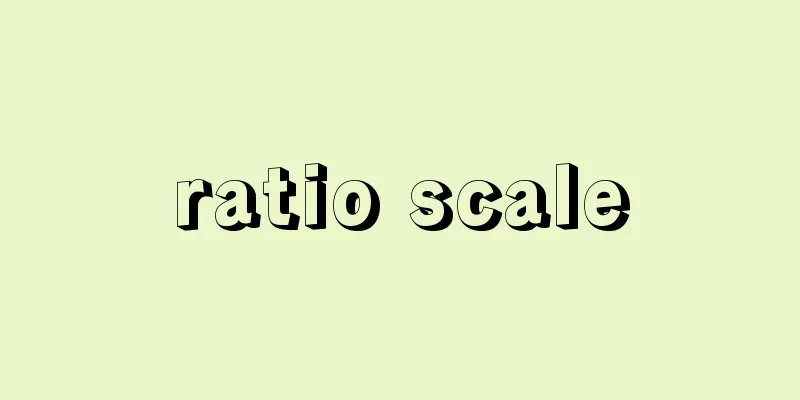Comics - Manga

|
A genre of painting that has been given various names such as caricature, satirical painting, Otsu-e, Toba-e, kyoga, caricature, cartoon, gekiga, and comic, or a general term for such a genre. [Isao Shimizu] Characteristics of mangaIt is extremely difficult to define what manga is in a few words. It is a free-spirited pictorial space, and its unique qualities lie in its lack of definition. Furthermore, the term "manga" itself was a relatively new term, established among the general public in the early Showa period. With the establishment of the term, it came to form a major field of modern reproduction art, on a par with photography, film, and posters. Therefore, if we were to define manga, it would be pictures drawn with a "spirit of playfulness" or a "spirit of satire". Interesting manga are pictures that contain a good balance of the spirits of "play" and "satire". Modern manga can be broadly divided into cartoons (single-picture comics) and comics (story comics). Comics are "frame comics" with a story that have developed worldwide since the 20th century under the influence of film and other media. They have been called manga novels, serial comics, picture stories, gekiga, etc. Pictures equivalent to manga are thought to have been drawn as early as humans learned how to draw, but with the invention of pigments, ink, brushes, and paper, methods of expression diversified and manga began to be drawn in large quantities. However, manga was originally destined to be discarded once a certain purpose had been achieved. This characteristic seems to be one of the reasons why so few works from ancient and medieval times, both in the East and the West, remain. Ancient Egyptian animal caricatures, ancient Greek vase painting caricatures, the caricature "Daidairon" from the Shosoin archives, and the "Choju Jinbutsu Giga" from Kosan-ji Temple in Kyoto are all valuable works that have been passed down to the present day. Such works were produced for the appreciation of a specific audience, but with the invention of printmaking technology, the situation changed dramatically. Manga began to be produced for the general public. In the absolute religious society of medieval Europe, woodblock prints played a role in religious propaganda, but also produced caricatures of religion that could be said to awaken humanity. For example, woodblock prints such as "Monks Entering a Nun's Room" convey distrust of the clergy. There were also many illustrations of high priests engaged in debauchery, which expressed distrust of religion and criticism of humanity. In copperplate prints, Jacques Callot in the 17th century, William Hogarth in the 18th century, and Goya produced caricatures that criticized society. In Japan, woodblock printing technology advanced during the Edo period, and among them, woodblock comic books called "Toba-e" books appeared in Osaka. Prints such as "Toba-e Sangokushi" and "Toba-e Akubi-dome", published from 1720 (Kyoho 5), were popular in Kyoto and Edo. Woodblock and copperplate printing required time and effort to create the master plates, and there was a limit to the number of copies that could be produced for each piece. As a result, it took some time before a single cartoon work had a major impact on popular society. Then, at the end of the 18th century, the lithography technique invented by the German Senefelder revolutionized the world of cartoons. Lithography, which makes use of the repulsive force between water and oil, required less time to create the master plates than woodblock and copperplate printing, and could be printed in large quantities, so it began to be used in journalism. This was the birth of topical satirical cartoons. Honoré Daumier made his debut as a lithographer in the weekly comic newspaper Silhouette, which was founded in 1829 with the support of French artists Émile Girardin and Honoré de Balzac, and another Frenchman, Charles Philipon (1800-1861/62), founded the weekly comic newspapers Caricature (1830) and Charivari (1832), which featured Daumier, Alexandre Gabriel Decamps (1803-1860), Nicholas Toussaint Charlet (1792-1845), Henri Monnier, and Paul Gavarni (1804-66). Printing technology further developed into color lithography, photo letterpress, stencil coloring, photo halftone printing, color photo letterpress, and offset printing, which made it possible to print in large quantities, and comic newspapers, comic magazines, newspaper comic supplements, and comic books began to appear one after another. In Japan, "Marumaru Chinbun," first published in 1877 (Meiji 10), was the first comic magazine to be mass-published (its first issue had over 5,000 copies published) using zinc letterpress printing, and "Tokyo Pack," first published in 1905 (Meiji 38) by Kitazawa Rakuten, boasted a circulation of tens of thousands using color photo letterpress printing. Then, in 1912 (Taisho 10), Japan's first regular newspaper Sunday supplement, "Jiji Manga," was printed in hundreds of thousands using offset printing. Today, computers are used in platemaking and printing, and many comic magazines have appeared that boast circulations of millions, on par with newspapers. In this way, modern manga and manga after the Second World War have developed in journalism and the mass media in both the East and the West, and continue to do so to this day. Furthermore, since the 1990s, with the spread of the Internet, cartoons and comics that can be viewed on computers and mobile phones have also appeared. [Isao Shimizu] History of mangaJapanAncient and medieval caricature works such as "Choju Jinbutsu Giga", "Hell Story", "Yamaino Soshi", and "Night Parade of One Hundred Demons Emaki" were hand-drawn and were the subject of appreciation for a certain segment of the public. Eventually, manga became a form of reproduction art expressed in woodblock prints, and was enjoyed by the masses. It all started with the Toba ehon, published in Osaka in the mid-Edo period. Toba e, named after Toba Sojo, said to be the originator of manga, was a woodblock manga book that used techniques of exaggeration and omission and was produced at a fairly early date in the world. In the early Edo period, Otsu e was merely a Buddhist painting from a single region called Otsu, but when the Edo Shogunate began to implement its policy of suppressing Christians, it came to be sought after as proof of Buddhist faith, and even after the number of caricature subjects increased, its talismanic nature was inherited and it gained popularity among the common people of Edo. They even used the word "Otsu e" to mean today's manga. In the late Edo period, Hokusai Manga (vol. 1, 1814) and Manga Hyakujo (vol. 1, 1814) were published, but the "manga" used here was a derivative of the existing "manpitsu," which had a similar meaning to today's "sketch." The word "kyoga" (crying painting) was also derived from "kyoka" (crying poem). In addition, there were more than 100 words that meant manga throughout the Edo period, including moji-e (letter picture), sayae (scabbard copy), monuke-e (puzzle), hitofude-e (one-stroke picture), and shadow pictures. A catfish picture, which was based on catfish, which was believed to cause earthquakes, went on sale immediately after the Ansei earthquake in 1855 (Ansei 2), and sold like hotcakes, with the number of types reaching nearly 300. This clearly shows how deeply manga had become part of the lives of the Edo people. Modern Japanese manga began under European influence. Influenced by the comic magazine Japan Punch, which was launched in 1862 (Bunkyu 2) in the Yokohama foreign settlement by the Englishman Charles Wirgman, comics began appearing in Japanese newspapers at the end of the Edo period. In 1874 (Meiji 7), Kanagaki Robun and Kawanabe Kyosai published E-shinbun Nipponchi, an exact imitation of Japan Punch. This was Japan's first comic magazine (printed by woodblock print). Manga of the Meiji period were also depicted in Nishikie prints by ukiyo-e artists. The customs of the enlightened age became the perfect theme for manga. These include Kawanabe Kyosai's "Kyōsai Rakuga" series, Shōsai Ikkei's "Thirty-six Playful Selections of Famous Places in Tokyo" series, Tsukioka Yoshitoshi's "Famous Places of Modernization in Tokyo Kyoga" series, and Kobayashi Kiyochika's "Kiyochika Punch" and "Hyakumenso" series. The first full-fledged comic magazine was Dandan Chinbun, founded in 1877 by Hiroshima-born Nomura Fumio. The first was the Western-style painter Honda Kinkichirō (1850-1921), who was the first to draw cartoons using pen and nail, gaining popularity for his sharp satire of clan-based politics. Next came Kobayashi Kiyochika, who depicted social conditions and customs at the height of the Freedom and People's Rights Movement in his powerful lithograph cartoons. Georges Bigot and Taguchi Beisaku (1864-1903) also drew cartoons for this magazine. Influenced by Wagman and Bigot, Nagahara Kotaro (1864-1930) drew cartoons for every issue of Mori Ogai's magazine Mesamashigusa. Nagahara also published an irregular manga magazine called Tobae. In the 1890s, people born in the Meiji period, such as Kitazawa Rakuten and Kosugi Misei (Kosugi Hoan), began drawing cartoons. Rakuten adopted the Western manga style of the time and became a popular manga artist with his sophisticated and realistic drawing style. In particular, Tokyo Pack, which was launched in 1905 (Meiji 38), was very well received for its large format like nishikie prints and full-page color cartoons, and brought him wealth and fame. Rakuten's success inspired many young men to pursue a career as a manga artist. In August 1912, Okamoto Ippei joined the Asahi Shimbun Company, in 1914 Ikebe Hitoshi (1886-1969) joined the Kokumin Shimbun Company, and the following year Kondo Koichiro joined the Yomiuri Shimbun Company, and each of them began drawing manga. It was a time when manga artists were journalists in charge of manga for newspapers. In 1915, these newspaper cartoonists in Tokyo formed a group called the Tokyo Manga Society and began to promote the work of manga artists to the public. During the Taisho period, manga magazines such as Tobae (1916), Manga (1917), Aka (1919), and Humor (1926) were launched, but all of them were short-lived. However, in 1936, the Jiji Shimpo launched the Sunday supplement Jiji Manga (edited by Kitazawa Rakuten) as a way to attract readers. This was the first regularly published manga supplement, and with Rakuten and his followers prolific writing, it was renamed Manga and Readings in 1931 and Manga and Photography in 1932, and continued to run until 1933. In 1923, the series "Masa-chan's Adventures" (written by Oda Shosei (Oda Nobutsune, 1889-1967) and illustrated by Kabashima Katsuichi) in Asahi Graph and "Nonkina Tousan" (by Aso Yutaka (1898-1961)) in the Hochi Shimbun gained popularity, and national comic heroes began to appear. Then, the new genre of children's comics came into the spotlight, and in the Showa era, Kodansha and Nakamura Shoten began publishing one hit work after another in this field. These include "The Three Musketeers in Boots" (written by Makino Taisei (1894-1964) and illustrated by Imoto Suimei (1893-1953)), "Norakuro" (by Tagawa Suiho), "Adventure Dankichi" (by Shimada Keizo (1900-73), all published by Kodansha), "Magic Sho-chan" (by Shaka Bontaro (1892-1963)), "Mars Exploration" (written by Asahi Taro (1901-40) and illustrated by Oshiro Noboru (1905-98)), and "A Boy's Conquest of the Jungle" (by Haga Takashi (1909-63), all published by Nakamura Shoten). Yokoyama Ryuichi's "Fuku-chan" (serialized in the Asahi Shimbun) was also popular before and during World War II. The publication of children's manga, which began to appear towards the end of the Taisho period, peaked between 1933 and 1938, after which it rapidly declined. This was due to the imposition of restrictions on children's manga with the enforcement of the National Mobilization Law in 1938. The "Home Ministry Instructions Concerning Children's Reading Material and Picture Books" issued by the Library Division of the Ministry of Home Affairs in the autumn of that year included instructions to abolish manga supplements and vulgar manga, to reduce the amount of manga in magazines, and in particular to reduce long manga. Popular manga serials such as "Norakuro" in "Shounen Club" also disappeared as a result of this instruction. After the Second World War, so-called postwar manga went through several booms, with the proportion of story-based manga (dramatic comics and manga) increasing. The first boom was the boom in manga magazines launched in 1946 (Showa 21). Dozens of titles were launched, including "Kumanbachi" (Tokyo Akaihoshisha), "VAN" (Evening Star), and "Shinmanga" (Usuda Shoten). This boom lasted for about three years. During this time, children's manga with a cinematic expression technique that was conscious of Tezuka Osamu's animation became popular, and this style had a great influence on manga after the Second World War. This was followed by "Manga Dokushohon" (Bungeishunjusha), which was launched at the end of 1954 and became popular, ushering in a second manga boom. Around this time, rental bookstores also flourished, and rental manga magazines such as "Kage" (1956, Hinomaru Bunko) and "Machi" (1957, Central Publishing) were launched. The term "gekiga" was then given to the realistic story manga that was aimed at young readers. In 1959, Shirato Sanpei published "Ninja Bugeicho" (17 volumes, Sanyosha), which caused a sensation and ushered in a gekiga boom. In 1959, the first weekly boys' manga magazines, "Shonen Sunday" (Shogakukan) and "Shonen Magazine" (Kodansha), were launched. The former gained popularity with works such as "Obake no Q-taro" (Fujiko Fujio), and the latter with "Kyojin no Hoshi" (Star of the Giants) (written by Kajiwara Ikki (1936-87) and illustrated by Kawasaki Noboru (1941- )). In 1966, "Shonen Magazine" surpassed one million copies in sales. In 1978, thanks to the popularity of Gaki Deka (Yamagami Tatsuhiko, 1947-), Shonen Champion (Akita Shoten) exceeded 2 million copies in circulation. In 1980, the combined circulation of the New Year's issues of five boys' weekly magazines exceeded 10 million copies. In 1994 (Heisei 6), Shonen Jump (Shueisha) recorded a circulation of 6.53 million copies. This was just before the serialization of Dragon Ball (Toriyama Akira, 1955-) ended. Manga magazines now come in a variety of genres, from children, girls, young men, and women to the middle-aged generation, but circulation peaked at 1.9 billion copies per year (comic magazines and comic books combined) in the mid-1990s and has since been on a downward trend. The reasons for this include the declining birthrate and a tendency to spend money and time on games, mobile phones, the Internet, etc., but the thriving manga cafes and second-hand bookstores, which are recycling-type second-hand bookstores, show that the number of manga fans is not decreasing. However, the emergence of manga cafes and second-hand bookstores has reduced sales of manga books, having a major impact on publishers and manga artists. Japanese television anime began to gain popularity around the world in the 1970s, and with the release of "Nausicaä of the Valley of the Wind" by Hayao Miyazaki in 1984, theatrical anime also began to attract attention around the world. Then, in the 1990s, so-called media mix entertainment emerged, which shared fans of games and anime, and the iconic work of this genre, "Pokémon" (Nintendo, Game Freak, Creatures), became a hit in Japan and around the world. Manga and anime characters are also being used to advertise and promote products, and there are many popular characters, such as "Anpanman," that earn hundreds of millions in royalties every year. The rise of the character business, which generates huge profits, has led to a trend toward stricter copyright laws, and in 1998, the U.S. Congress passed a law extending copyright protection from 75 years after publication to 95 years, and from 50 years after the death of the author to 70 years. This has created a gap with Japan, where copyright protection is limited to 50 years after the death of the author. Furthermore, technological innovations such as computer graphics for manga production and the distribution of manga works over the Internet are also transforming the world of manga. In the 1990s, there were more than 4,000 manga artists, and the industry employed 20,000 assistants. [Isao Shimizu] WesternIn the history of painting, which began in prehistoric times, the paintings that were the starting point were drawn in a caricatured style, so it is difficult to distinguish caricatures from general paintings. However, it seems that caricatures began in paintings other than those with a magical or religious meaning, such as allegorical paintings. Examples include the animal caricatures of ancient Egypt. In ancient Greece, human actions appeared as a caricature theme. In medieval society, religious caricatures were drawn out of a desire to repel the oppression of religion, which held absolute power. During the Renaissance, caricatures that looked more deeply into the inner world of humans began to be drawn. Then came the people who built the foundations of Western comics, such as Leonardo da Vinci, Hieronymus Bosch, Pieter Bruegel, and Giuseppe Arcimboldo. In the 17th century, the French artist Jacques Callot began to depict the realities of human society using the forms of improvised masked theatre and clowning that were popular at the time. His copperplate print series, "The Misery and Misfortune of War," would later influence Goya. In the 18th century, British artists such as Hogarth, Thomas Rowlandson (1756-1827), and James Gillray (1756/57-1815), as well as the Spanish artist Goya, produced excellent caricatures that laid the foundations for modern cartoons. Hogarth's efforts to get Parliament to enact copyright law are particularly significant in the history of cartoons. In the 19th century, with the advancement of printing technology, such as the introduction of lithography, comic newspapers, comic magazines, and comic books became popular, and artists such as Daumier, Monnier, and Gavarni in France, George Cruikshank (1792-1878) and Richard Doyle (1824-83) in England, and Wilhelm Busch in Germany were active. Photography, which was invented in the 19th century, had a great influence not only on painters but also on cartoonists. To compete with the realism of portrait photography, caricature cartoons, which placed emphasis on the face, were born. Such portrait cartoons were drawn at the beginning of comic magazines such as L'Eclipse, Lune, and L'Ire. At the end of the 19th century, while French artists such as Steinlen, Jean-Louis Forain (1852-1931), and Toulouse-Lautrec were drawing genre comics, serialized comic strips began to appear in American newspapers. The first of these was The Yellow Kid by Richard Felton Outcault (1863-1928) in The World, marking the beginning of the history of the comic strip. In the 20th century, serialized comic strips and story comics flourished. Their depictions were also influenced by filmic methods of expression. Animation, which uses animated comic strips, also developed rapidly in the 20th century. Many cartoonists produced satirical cartoons during the two world wars, the greatest tragedies of the 20th century. During World War I, Louis Reemaker of the Netherlands produced fierce anti-German and anti-war cartoons, and the German Kaiser offered him a bounty to pursue. After the war, George Gross emerged from defeated Germany, producing anti-war and anti-militarist cartoons. Gross's style had a major influence on Japanese cartoonists such as Shimokawa Hekoten/Oten (1892-1973) and Yanase Masamu. During World War II, Russia's Kukurniksy (a group of three) and Britain's Law produced some of the most outstanding cartoonists. After World War II, cartoonists who became famous worldwide included France's Cine, Sempé, André François, Raymond Peynet, Chabal, and Dubou, Britain's Ronald Searle and Gerald Scarfe, Switzerland's Giovannetti, Denmark's Jacobson, Russia's Kukulniksy and Efimov, and the United States' Saul Steinberg, Robert Osborne, Otto Soglou, Virgil Paci, and Charles Adams. Popular American strip comics such as Blondie by Chick Young, Peanuts by Charles M. Schulz (1922-2000), famous for the character Snoopy, and Dilbert by Scott Adams (1957- ), were published in newspapers around the world and gained avid readers all over the world. Political cartoonists such as Ranan Raymond Lurie (1932- ) of the United States, Giuseppe Zaccaria (1930-85) of France, and Heng Kim Song (1963- ) of Singapore have had their works reprinted in newspapers around the world. The Yomiuri International Cartoon Award, founded by the Yomiuri Shimbun in 1980, is the world's largest cartoon contest, receiving over 10,000 submissions from around the world each year. In 1992, the British comic magazine Punch closed its doors after 151 years of existence, but was revived in 1996. However, the satirical momentum that once influenced the global comics world has been lost. [Isao Shimizu] ChinaThe first recorded appearance of manga in China is said to be in the 11th century (Song Dynasty) in the cartoons in the painting "The Jade Emperor's Assembly" by Shi Ke. However, up until modern times, there were fewer cartoons and cartoonist works than in Japan, and no outstanding cartoonists or cartoon works were produced. From around 1875, cartoon magazines such as "Hong Kong Punch" appeared, but "manga" was a word imported from Japan during the Taisho period. Manga began to be actively drawn around the time of the Xinhai Revolution (1911). The democratic revolution aimed at anti-imperialist and anti-feudalism produced many cartoons, and manga became an independent field of art. Behind this was the development of journalism, within which manga was published. The first collection of cartoons, titled "Allegorical Paintings," was published in 1909, and "Shanghai Pack" was launched in 1918. This magazine is thought to have been influenced by Kitazawa Rakuten's "Tokyo Pack." In 1928, the weekly comic magazine "Shanghai Comics" was launched. Anti-Japanese comics were widely produced during the Fifteen-Year War between Japan and China, and after the birth of the People's Republic of China in 1949, comics have been widely used to spread revolutionary ideas and propaganda for nation building. Currently, comic magazines such as "Manga" and "Satire and Silence" are published regularly. Furthermore, in the 1990s, comic magazines influenced by Japan, Hong Kong, and Taiwan began to be published in China. [Isao Shimizu] AsiaLike China, comics are thought to have existed in Korea since ancient times, but their history is not very clear. In modern times, under Japanese rule, comic magazines such as "Keijo Pack" and "Manga Joseon" were published. After World War II, many comics were drawn in Korea as journalism developed, and Kim Seong-hwan's (1932-) four-panel comic "Koba-u" (serialized in "Dong-A Ilbo" and "Chosun Ilbo") became a nationally popular comic. In Indonesia, comics appeared during the nationalist movement from the mid-1920s to the early 1930s. "Uncle Pasicom" (G.M. Sudharta) in Kompas became popular from the 1970s, and was introduced to Japan in book form in 1985. In the Philippines, political cartoons were banned for a long time during the final years of the Marcos regime after World War II. Singaporean Heng Kim-sung's political cartoons have been reprinted in newspapers around the world. In general, manga flourished in Asian countries along with the development of journalism after the war. In 1996, the East Asia Manga Summit was held as a forum for interaction between manga artists from Japan, Korea, Taiwan, and Hong Kong. In addition, the ASEAN Manga Artists Exhibition (1990-94) and the Asian Manga Exhibition (since 1995), both of which are annually organized by the Japan Foundation, travel to various parts of Japan and other Asian countries, providing a forum for interaction through manga. [Isao Shimizu] "The Protagonists of Manga" by Sakuda Keiichi, Tada Michitaro, and Tsuganezawa Satoshihiro (1965, Shiseido)" ▽ "The World Encyclopedia of Manga" by Suyama Keiichi (1972, Bancho Shobo)" ▽ "The History of Chinese Manga" by Bi Keguan, translated by Ochiai Shigeru (1974, Chikuma Shobo)" ▽ "The History of Graphic Novels" by G. Blanchard, translated by Kubota Haniya (1974, Kawade Shobo Shinsha)" ▽ "The History of Postwar Manga Philosophy" by Katayose Mitsugu (1980, Miraisha)" ▽ "The Overall Picture of Contemporary Manga" by Go Tomohide (1986, Information Center Publishing Bureau)" ▽ "The 'Manga Boys' and Akahon Manga" by Shimizu Isao (1989, Zo-on Publishing)" ▽ "50 Years of Postwar Manga History" by Takeuchi Osamu (1995, Chikuma Shobo)" ▽ "Edo Satirical Illustrations by Minami Kazuo (1997, Yoshikawa Kobunkan)" ▽ "Aera Mook 24: A Guide to Comic Studies, edited and published by the Asahi Shimbun Company. (1997) ▽ Shimizu Isao, Osaka Manga History (1998, Newton Press) ▽ Hayashida Ryosuke, The Century of Caricature (1998, Hakusuisha) ▽ Shimizu Isao, ed., Illustrated History of Manga (1999, Kawade Shobo Shinsha) ▽ Shimizu Isao, The Birth of Manga - Departing from Taisho Democracy (1999, Yoshikawa Kobunkan) ▽ Shimizu Isao, The Birth of Modern Japanese Manga (2001, Yamakawa Publishing) ▽ Asia Center, Asia IN Comics Exhibition Catalogue (2001, Japan Foundation) ▽ Nakano Haruyuki, Manga Industry Theory (2004, Chikuma Shobo) ▽ Natsume Fusanosuke, A Challenge to Manga Studies - The Evolving Map of Criticism (2004, NTT Publishing) "The Great Manga Museum" edited by Matsumoto Leiji and Hidaka Satoshi (2004, Shogakukan Creative, published by Shogakukan)" ▽ "The History of Manga" by Shimizu Isao (Iwanami Shinsho)" ▽ "One Hundred Modern Japanese Manga Selected by Shimizu Isao (Iwanami Bunko)" ▽ "Manga of Edo: The Spirit of a Peaceful Age" by Shimizu Isao (Kodansha Academic Library)" [References] | | | | | | | | | | | | |Kondo | | | |Toba-e| | | | | | | | | | | |Source: Shogakukan Encyclopedia Nipponica About Encyclopedia Nipponica Information | Legend |
|
戯画、風刺画、大津絵、鳥羽絵(とばえ)、狂画、カリカチュアcaricature、カートゥーンcartoon、劇画、コミックcomicなど、多様な呼称がつけられた絵画分野、あるいはその総称。 [清水 勲] 漫画の特質漫画とは何かをひと口で定義することは非常にむずかしい。それは自由奔放な絵画空間であり、規定されないところにその特質が隠されているといえるからである。また「漫画」ということば自体、大衆のなかに定着したのは昭和初期という比較的新しいことであった。そのことばの確立によって、写真、映画、ポスターと並ぶ近代複製美術の一大分野を形成するようになる。 したがって、漫画をあえて定義すると「遊びの心」あるいは「風刺の心」をもって描いた絵ということになる。おもしろい漫画とはこの「遊び」の精神、「風刺」の精神がバランスよく含まれた絵だといえる。現代漫画はカートゥーン(一枚絵漫画)とコミック(ストーリー漫画)に大別できる。コミックは20世紀に入って映画などの影響を受けて世界的に発展してきたストーリーのある「こま漫画」である。漫画小説、連続漫画、絵物語、劇画などとよばれてきた。 漫画に相当する絵は、人間が絵を描くことを知ったころから描かれていたと思われるが、顔料・墨・筆・紙などが発明されることにより表現法が多様化し、大量に描かれるようになった。しかし、漫画は元来、描かれて一定の目的が達せられると捨て去られるのが宿命であった。洋の東西を問わず、古代・中世の作品で残されたものが少ないのは、そうした特質も影響しているように思われる。古代エジプトの動物戯画、古代ギリシアの壺絵(つぼえ)の戯画、正倉院古文書の戯画「大大論」、京都・高山寺の『鳥獣人物戯画』などは現代に伝えられた貴重な作品である。 そうしたものは特定の人々の鑑賞のために製作されたものであるが、版画技術が発明されると様相が一変する。不特定多数を対象にした漫画が描かれるようになるのである。 中世ヨーロッパの宗教絶対社会のなかで、木版画は宗教プロパガンダの役割を果たす一方で、人間性の目覚めともいうべき宗教に対する風刺画をも登場させる。たとえば、「尼僧の部屋に出入りする僧侶(そうりょ)」といった木版画に、聖職者への不信の念が感じられる。高僧たちの遊蕩(ゆうとう)図なども数多く描かれ、そこには宗教への不信と人間批判が込められていた。銅版画では17世紀のジャック・カロ、18世紀のウィリアム・ホガース、ゴヤなどが社会に対する批判を込めた風刺画を描き出す。日本では江戸時代になると木版画技術が進歩し、そのなかで「鳥羽絵」本とよばれる木版漫画本が大坂に登場する。1720年(享保5)から刊行された『鳥羽絵三国志』『鳥羽絵欠(あく)び留(どめ)』などの版本で、京都や江戸でも人気を博した。 木版画と銅版画は原版をつくるうえに手間暇がかかり、1点当りの製作枚数にも限度があった。したがって、一つの漫画作品が大衆社会に大きな影響力を及ぼすまでにはまだ時間がかかった。そして18世紀末、ドイツのゼーネフェルダーによって発明された石版画(リトグラフ)技術は漫画の世界に革命をもたらすに至る。水と油の反発力を利用した石版画は、木版画・銅版画に比して原版製作に時間がかからず、大量に刷ることができるため、ジャーナリズムのなかに利用されるようになる。すなわち、時局風刺漫画の登場である。1829年、フランスのエミール・ジラルダン、オノレ・ド・バルザックらに後援されて創刊された週刊漫画新聞『シルエット』にはオノレ・ドーミエが石版漫画家としてデビューし、同じくフランス人のシャルル・フィリポンCharles Philipon(1800―61/62)が創刊した週刊漫画新聞『カリカチュール』(1830)、『シャリバリ』(1832)にはドーミエ、アレクサンドル・ガブリエル・ドゥカンAlexandre Gabriel Decamps(1803―60)、ニコラス・トゥーサン・シャルレNicholas Toussaint Charlet(1792―1845)、アンリ・モニエ、ポール・ガバルニPaul Gavarni(1804―66)などが石版漫画家として活躍した。 印刷技術はさらに、色彩石版印刷、写真凸版印刷、ステンシル彩色、写真網版製版、色彩写真凸版印刷、オフセット印刷と発展し、大量部数の発行が可能となって漫画新聞、漫画雑誌、新聞漫画付録、漫画本が続々と登場するようになる。日本では1877年(明治10)創刊の『団団珍聞(まるまるちんぶん)』が亜鉛凸版印刷による初の大量発行漫画誌(創刊号は5000部以上発行)となり、1905年(明治38)北沢楽天(らくてん)が創刊した『東京パック』は色彩写真凸版印刷により万単位の発行部数を誇った。そして、21年(大正10)日本最初の定期刊行新聞日曜付録『時事漫画』はオフセット印刷によって10万単位の部数を発行するに至る。現代では製版・印刷にコンピュータが駆使され数百万部という新聞並みの発行部数を誇る漫画雑誌がいくつも登場している。このように近代漫画や第二次世界大戦後の漫画は洋の東西を問わず、ジャーナリズム、マスコミのなかで発展し今日に至っている。また、1990年代以降はインターネットの普及により、パソコンで見られるカートゥーンやコミック、携帯電話で読めるコミックも登場した。 [清水 勲] 漫画の歴史日本『鳥獣人物戯画』『地獄草紙』『病草紙(やまいのそうし)』『百鬼夜行(ひゃっきやこう)絵巻』などの古代・中世戯画作品は、肉筆で描かれ、一部の人々の鑑賞の対象になっていた。やがて漫画は版画で表現するという複製美術となり、大衆の享受するものになった。その出発点は江戸中期に大坂で出された鳥羽絵本である。漫画の元祖といわれていた鳥羽僧正(とばそうじょう)の名を冠した鳥羽絵は、誇張や省略の技法を使った世界的にみてかなり早い時代に生み出された木版漫画本だった。江戸初期、大津という一地方の仏画にすぎなかった大津絵は、江戸幕府がキリシタン弾圧政策を行いだすと仏教徒の証(あかし)として求められるようになり、戯画的主題が多くなってからも、その護符的性格が受け継がれて江戸庶民の人気を得た。彼らは今日の漫画を意味するものとして「大津絵」ということばを使ったほどだった。江戸後期には『北斎(ほくさい)漫画』(第1編、1814)、『漫画百女(ひゃくじょ)』(1814)といった版本が出るが、ここで使われた「漫画」は従来からあった「漫筆」から派生したことばで、今日の「スケッチ」のような意味であった。「狂歌」から「狂画」ということばも派生している。このほか江戸時代を通じて使われた漫画を意味することばとしては、文字絵、鞘絵(さやえ)(鞘写し)、もぬけ絵、判じ物、一筆(ひとふで)絵、影絵など100種以上ある。1855年(安政2)の安政(あんせい)大地震直後に売り出され、地震をおこすものと信じられていた鯰(なまず)をテーマにした鯰絵は、飛ぶように売れてその数は300種近くに達した。漫画というものが江戸の人々の生活に深く入り込んでいたことがよくわかる。 日本の近代漫画は、ヨーロッパの影響を受けてスタートする。1862年(文久2)に横浜居留地でイギリス人チャールズ・ワーグマンによって創刊された漫画雑誌『ジャパン・パンチ』の影響を受けて、幕末の日本の新聞に漫画が掲載されるようになる。1874年(明治7)には仮名垣魯文(かながきろぶん)・河鍋暁斎(かわなべきょうさい)によって『ジャパン・パンチ』をそっくりまねた『絵新聞日本地(にっぽんち)』が刊行される。日本最初の漫画雑誌(木版刷)である。明治の漫画は、浮世絵師たちによって錦絵(にしきえ)のなかにも描かれる。文明開化風俗が絶好の漫画テーマになったのである。河鍋暁斎の「暁斎楽画」シリーズ、昇斎一景(しょうさいいっけい)の「東京名所三十六戯撰(ぎせん)」シリーズ、月岡芳年(よしとし)の「東京開化狂画名所」シリーズ、小林清親(きよちか)の「清親ポンチ」「百面相」シリーズなどである。本格的な漫画雑誌は、1877年に広島県出身の野村文夫によって創刊された『団団珍聞(まるまるちんぶん)』である。まず洋画家の本多錦吉郎(きんきちろう)(1850―1921)がペンを使った漫画を初めて描き、藩閥政治を辛辣(しんらつ)に風刺して人気をよぶ。ついで小林清親が迫力ある石版漫画で自由民権運動高揚期の風俗世相を描く。ジョルジュ・ビゴーや田口米作(べいさく)(1864―1903)もこの雑誌に漫画を描いた。ワーグマンやビゴーの影響を受けた長原孝太郎(1864―1930)は森鴎外(おうがい)の主宰した雑誌『めさまし草(ぐさ)』に毎号漫画を描いた。長原は自身でも『とばえ』という不定期刊の漫画雑誌を出した。明治も30年代に入ると、北沢楽天や小杉未醒(みせい)(小杉放庵(ほうあん))のような明治生まれの人々が漫画を描き出す。楽天は当時の欧米漫画のスタイルを取り入れ、あか抜けたリアルな画風で人気漫画家になる。とくに1905年(明治38)に創刊した『東京パック』は錦絵のような大判で、全ページがカラー漫画であることで大好評を博し、富と名声を獲得する。楽天の成功によって職業としての漫画家を目ざす青年たちが出てくる。 1912年8月、岡本一平が朝日新聞社に入社、14年池部鈞(ひとし)(1886―1969)が国民新聞社に入社、その翌年近藤浩一路(こういちろ)が読売新聞社に入社してそれぞれ漫画を描き始める。漫画家といえば新聞社の漫画担当記者といった時代だった。15年、そうした在京の新聞漫画家が東京漫画会というグループを結成し、漫画家の仕事を世間に宣伝しだす。大正期には『トバエ』(1916)、『漫画』(1917)、『赤』(1919)、『ユーモア』(1926)といった漫画誌が創刊されるが、いずれも短命に終わる。しかし、21年に『時事新報』が読者獲得の手段として創刊した日曜付録『時事漫画』(北沢楽天主筆)は初の定期刊行漫画付録で、楽天とその門人たちが健筆を振るい、31年(昭和6)『漫画と読物』、32年『漫画と写真』と改題して33年まで続く。 1923年、『アサヒグラフ』の連載『正チャンの冒険』(織田小星(しょうせい)(織田信恒、1889―1967)文・樺島勝一(かばしまかついち)画)、『報知新聞』連載の『ノンキナトウサン』(麻生豊(あそうゆたか)(1898―1961))が人気を博し、国民的な漫画ヒーローが登場するようになる。そして新たに児童漫画というジャンルが脚光を浴び、昭和に入ると講談社や中村書店がその分野で話題作を次々と刊行していく。『長靴の三銃士』(牧野大誓(たいせい)(1894―1964)文・井元水明(いもとすいめい)(1893―1953)画)、『のらくろ』(田河水泡(すいほう))、『冒険ダン吉』(島田啓三(1900―73)、以上講談社)、『魔法の昭(しょう)ちゃん』(謝花凡太郎(しゃかぼんたろう)(1892―1963))、『火星探険』(旭太郎(1901―40)作・大城(おおしろ)のぼる(1905―98)画)、『坊やの密林征服』(芳賀たかし(1909―63)、以上中村書店)などである。横山隆一の『フクちゃん』(『朝日新聞』連載)も第二次世界大戦前・戦中の人気漫画となった。 大正末期から登場しだした児童漫画の出版は、1933年から38年までがピークで、以後は急速に減少していく。それに38年の国家総動員法の施行により、児童漫画に規制が加えられたからである。同年秋に発表された内務省図書課の「児童読物、並(ならび)に絵本に関する内務省指示事項」には、付録漫画や低俗漫画を廃止すること、雑誌のなかの漫画の量を減らすこと、とくに長編漫画を減らすことなどが記されている。『少年倶楽部(くらぶ)』の人気漫画であった「のらくろ」などの連載もこの指示で消えていく。 第二次世界大戦後のいわゆる戦後漫画は、何度かのブームを経ながらストーリー物(劇画・コミック)の比重を増大させていく。最初のブームは1946年(昭和21)の漫画雑誌創刊ブームである。『クマンバチ』(東京赤い星社)、『VAN』(イブニング・スター社)、『新漫画』(臼田(うすだ)書店)など数十種が創刊された。このブームは3年ほど続く。この間、手塚治虫(おさむ)のアニメ化を意識した映画的表現手法の児童漫画が人気を博し、そのスタイルは第二次世界大戦後の漫画に大きな影響を与える。続いて54年末に創刊された『漫画読本』(文芸春秋社)が人気をよび、第二次漫画ブームが到来する。このころ貸本屋も隆盛の時代を迎え、貸本漫画誌として『影』(1956、日の丸文庫)、『街』(1957、セントラル出版社)などが創刊される。そしてそこに描かれる青少年を読者対象にしたリアルな描写のストーリー漫画に「劇画」という名称がつけられる。59年、白土三平(しらとさんぺい)が『忍者武芸帳』(全17巻、三洋社)を刊行しだすと話題をよび、劇画ブームがやってくる。59年、初の少年週刊漫画誌『少年サンデー』(小学館)、『少年マガジン』(講談社)が創刊される。前者は「オバケのQ太郎」(藤子不二雄(ふじこふじお))などで、後者は「巨人の星」(梶原一騎(かじわらいっき)(1936―87)作・川崎のぼる(1941― )画)などで人気を得る。66年、『少年マガジン』は100万部を突破した。78年には「がきデカ」(山上たつひこ(1947― ))の人気で『少年チャンピオン』(秋田書店)が200万部を突破する。80年には、少年週刊誌5誌の新年号発行部数が計1000万部を突破する。94年(平成6)には、『少年ジャンプ』(集英社)は653万部発行を記録した。これは『ドラゴンボール』(鳥山明(1955― ))連載終了直前の現象であった。漫画雑誌は子供向き、少女向き、青年向き、女性向きからさらには中年世代向きまで現れるが、1990年代なかばの年間19億冊(漫画雑誌と漫画本の合計)発行をピークに減少傾向となる。 その背景には少子化、ゲームや携帯電話やインターネットなどに金と時間を消費する傾向があげられるが、漫画喫茶や新古書店といわれるリサイクル型古書店の盛況は、漫画ファンが減少しているわけではないことを示している。しかし、漫画喫茶や新古書店の登場は、漫画本の売上げを減らし、出版社や漫画家に大きな影響を与えている。 1970年代から日本のテレビアニメは世界中で人気を博し、84年(昭和59)の宮崎駿(はやお)による『風の谷のナウシカ』の登場によって、劇場用アニメも世界で注目されるようになる。そして、90年代にはゲームやアニメなどとファンを共有する、いわゆるメディアミックスのエンターテインメントが登場、その象徴的な作品『ポケットモンスター』(任天堂・ゲームフリーク・クリーチャーズ)が日本および世界でヒットする。 漫画やアニメのキャラクターは商品の宣伝、販売促進にも利用されだし、人気キャラクターのなかには「アンパンマン」など、毎年億単位の使用料を得るものがいくつも出てきている。巨大な利益を生み出すキャラクター・ビジネスの隆盛は、著作権をより厳格にする傾向を生み出し、1998年、アメリカ議会は著作権保護期間を、作品発表後75年間を95年間に、作家の死後50年間を70年間に延長する法律を可決した。そのため作家の死後50年間としている日本との差が生じてきた。 また、コンピュータ・グラフィクスによる漫画製作、インターネット上の漫画作品配信など、技術革新は漫画の世界も変革しようとしている。1990年代のコミック作家は4000人を超え、アシスタントを2万人抱える産業になった。 [清水 勲] 西洋先史時代から始まる絵画の歴史のなかで、その出発点となっている絵画類は戯画的描法をとっているから、戯画と一般絵画との区別はつけにくいが、呪術(じゅじゅつ)的あるいは宗教的意味で描かれた絵画以外の絵、たとえば寓意(ぐうい)画のなかに戯画の出発点があるように思える。古代エジプトの動物戯画などがその例である。古代ギリシアでは人間の所業が戯画テーマとして登場してくる。中世社会では絶対的権力をもっていた宗教に対して、その重圧を跳ね返さんとする欲求から宗教風刺画が描かれる。ルネサンス期になると人間の内面をより深く見つめた風刺画が描かれるようになる。そしてレオナルド・ダ・ビンチ、ヒエロニムス・ボス、ピーター・ブリューゲル、ジュゼッペ・アルチンボルドなど西洋漫画の基盤をつくる人々が登場する。 17世紀に入るとフランスのジャック・カロが、当時流行した即興仮面劇や道化芝居の形式を踏んで人間社会の現実を描き出した。彼の銅版画シリーズ「戦争の悲惨と不幸」はのちにゴヤに影響を与える。18世紀にはイギリスのホガース、トマス・ローランドソンThomas Rowlandson(1756―1827)、ジェームズ・ギルレーJames Gillray(1756/57―1815)、スペインのゴヤなどが優れた風刺画を描き近代漫画の基盤をつくりだす。とくにホガースが議会に諮って著作権法を制定させたことは、漫画の歴史にとってきわめて意義深いことである。19世紀に入ると石版刷の導入という印刷技術の進歩により漫画新聞・漫画雑誌・漫画本が盛んに刊行されるようになり、フランスのドーミエ、モニエ、ガバルニ、イギリスのジョージ・クルークシャンクGeorge Cruikshank(1792―1878)、リチャード・ドイルRichard Doyle(1824―83)、ドイツのウィルヘルム・ブッシュなどが活躍した。19世紀に発明された写真は、画家のみならず漫画家にも大きな影響を与える。肖像写真の表現する迫真性に対抗するため、顔に力点の置かれた似顔絵漫画が誕生するのである。『レクリプス』『リュヌ』『リール』などの漫画雑誌の巻頭にそうした肖像漫画が描かれた。 19世紀末、フランスでスタンラン、ジャン・ルイ・フォランJean-Louis Forain(1852―1931)、ロートレックなどが風俗漫画を描いていたころ、アメリカでは新聞に連載漫画が登場し始めた。『ザ・ワールド』紙に載ったリチャード・フェルトン・アウトコールトRichard Felton Outcault(1863―1928)の『イエロー・キッド』がその最初で、コミック・ストリップの歴史がここから始まる。20世紀は連載漫画やストーリー漫画が花開く。そして、その描写は映画の表現方法からも数々の影響を受ける。また漫画を動かして見せるアニメーションも20世紀に入って急速に発展していく。 20世紀の最大の悲劇である二つの世界大戦には、多くの漫画家が風刺漫画を描く。第一次世界大戦中、オランダのルイス・レーメーカーは激しい反ドイツ漫画・反戦漫画を描き、ドイツ皇帝から賞金付きで行方を追跡される。この大戦後、敗戦国ドイツからゲオルゲ・グロッスが登場し、反戦・反軍国主義の風刺画を描く。グロッスの画風は下川凹天(へこてん/おうてん)(1892―1973)、柳瀬正夢(やなせまさむ)などの日本の漫画家に大きな影響を与える。第二次世界大戦では、ロシアのククルニクスイ(3人からなるグループ名)、イギリスのローなどが優れた風刺画を描いた。 第二次世界大戦後の漫画家として世界的に知られるのは、フランスのシネ、サンペ、アンドレ・フランソア、レイモン・ペイネ、シャバル、デュブウ、イギリスのロナルド・サール、ジェラルド・スカーフ、スイスのジョバネッティ、デンマークのヤコブソン、ロシアのククルニクスイ、エフィモフ、アメリカのソウル・スタインバーグ、ロバート・オズボーン、オットー・ソグロー、バージル・パーチ、チャールズ・アダムスなどの人々である。チック・ヤングの『ブロンディ』、キャラクターのスヌーピーで有名なチャールズ・M・シュルツCharles M. Schulz(1922―2000)の『ピーナッツ』、スコット・アダムズScott Adams(1957― )の『ディルバート』などアメリカの人気こま漫画は、世界各国の新聞に掲載されて世界中に愛読者をもつようになる。政治漫画でもアメリカのラナン・R・ルリーRanan Raymond Lurie(1932― )、フランスのジュゼッペ・ザッカリアGiuseppe Zaccaria(1930―85)、シンガポールのヘン・キムソン(1963― )などはその作品が世界各国の新聞に転載されている。 1980年、読売新聞社が創設した読売国際漫画大賞は、世界各国から毎年1万点余りの応募がある世界最大のカートゥーンコンテストとなっている。92年、イギリスの漫画雑誌『パンチ』が151年の歴史を閉じたが、96年に復活した。しかし、かつての世界の漫画界に影響を与えた風刺の勢いは失われている。 [清水 勲] 中国中国において記録のうえで漫画が登場した最初は11世紀(宋(そう)代)の石恪(せきかく)筆『玉皇朝会図』の画中に描かれた風刺画だという。しかし、近代に至るまでは日本に比して漫画や風刺画の作品は少なく、傑出した漫画家や漫画作品が出ていない。1875年ごろから『香港(ホンコン)パンチ』などの漫画雑誌が登場するが、「漫画」は大正時代に日本から輸入されたことばであった。漫画が活発に描かれるようになるのは辛亥(しんがい)革命(1911)前後からである。反帝反封建を目ざす民主革命が多くの風刺画を生み出し、漫画が独立した美術分野になる。その背景にはジャーナリズムの発展があり、そのなかに漫画が発表されたのである。1909年に『寓意画』と題する初の漫画集が刊行され、18年には『上海(シャンハイ)パック』が創刊される。この雑誌は北沢楽天の『東京パック』の影響を受けたものだと思われる。28年には週刊漫画雑誌『上海漫画』が創刊される。日中十五年戦争時代には抗日漫画が盛んに描かれ、49年の新中国誕生以降は革命思想の普及と国家建設の教宣に漫画は大いに利用される。現在は『漫画』『風刺と幽黙』という漫画専門誌が定期刊行されている。また、1990年代に入り、中国でも日本や香港、台湾の影響を受けてコミック誌が出されるようになった。 [清水 勲] アジア朝鮮も中国同様に古代から漫画は存在したと思われるが、その歴史はあまり明らかでない。近代以降、日本の支配下では『京城パック』『漫画朝鮮』といった漫画雑誌が出された。第二次世界大戦後、韓国ではジャーナリズムの発展のなかで漫画が数多く描かれ、金星煥(きんせいかん/キムソンファン)(1932― )の四こま漫画『コバウ』(『東亜日報』・『朝鮮日報』などに連載)は国民的人気漫画となっている。インドネシアでは1920年代なかばから30年代初頭にかけての民族運動時代から漫画が登場してくる。70年代から『コンパス』紙の『パシコムおじさん』(G・M・スダルタ)が人気をよび、日本にも85年、単行本になって紹介された。フィリピンでは第二次世界大戦後のマルコス政権末期、政治風刺画が禁じられる時代が続いた。シンガポールのヘン・キムソンの政治漫画は世界各国の新聞に転載されている。アジア諸国は総じて、戦後のジャーナリズム発展とともに漫画が開花したといえる。1996年より、日本、韓国、台湾、香港のコミック作家たちの交流の場である「東アジアMANGAサミット」が開催され始めた。また、国際交流基金が毎年主催する「アセアン漫画家展」(1990~94)、「アジア漫画展」(1995~)は、日本各地およびアジア諸国に巡回され、漫画を通じての交流の場となっている。 [清水 勲] 『作田啓一・多田道太郎・津金沢聡広著『マンガの主人公』(1965・至誠堂)』▽『須山計一著『漫画博物志・世界編』(1972・番町書房)』▽『畢克官著、落合茂訳『中国漫画史話』(1974・筑摩書房)』▽『G・ブランシャール著、窪田般彌訳『劇画の歴史』(1974・河出書房新社)』▽『片寄みつぐ著『戦後漫画思想史』(1980・未来社)』▽『呉智英著『現代マンガの全体像』(1986・情報センター出版局)』▽『清水勲著『「漫画少年」と赤本マンガ』(1989・ゾーオン社)』▽『竹内オサム著『戦後マンガ50年史』(1995・筑摩書房)』▽『南和男著『江戸の風刺画』(1997・吉川弘文館)』▽『朝日新聞社編・刊『アエラムック24 コミック学のみかた。』(1997)』▽『清水勲著『大阪漫画史』(1998・ニュートン・プレス)』▽『林田遼右著『カリカチュアの世紀』(1998・白水社)』▽『清水勲編著『図説漫画の歴史』(1999・河出書房新社)』▽『清水勲著『マンガ誕生――大正デモクラシーからの出発』(1999・吉川弘文館)』▽『清水勲著『日本近代漫画の誕生』(2001・山川出版社)』▽『アジアセンター編『アジアINコミック展』図録(2001・国際交流基金)』▽『中野晴行著『マンガ産業論』(2004・筑摩書房)』▽『夏目房之介著『マンガ学への挑戦――進化する批評地図』(2004・NTT出版)』▽『松本零士・日高敏編著『漫画大博物館』(2004・小学館クリエイティブ、小学館発売)』▽『清水勲著『漫画の歴史』(岩波新書)』▽『清水勲編『近代日本漫画百選』(岩波文庫)』▽『清水勲著『江戸のまんが 泰平の世のエスプリ』(講談社学術文庫)』 [参照項目] | | | | | | | | | | | | | | | | | | | | | | | | | | | | |出典 小学館 日本大百科全書(ニッポニカ)日本大百科全書(ニッポニカ)について 情報 | 凡例 |
Recommend
Centipede seaweed - Grateloupia filicina
A seaweed of the family Clenchedriaceae in the ord...
Moby-Dick; or The Whale
A full-length novel by American author Melville. ...
Elector - Senkyonin
1. A person who has the right to vote. 2 In the US...
At-Tāif (English spelling)
A city in the Hijaz region of western Saudi Arabia...
Kinarikodo - Kannarikodo
…In the Edo period, Sawabe, Kanari, and Arikabe w...
Society of Artists of Great Britain
...After that, the Salon de la Société des artist...
Moving iron type gauge - moving iron type gauge
...As an ammeter, it is desirable for the interna...
Iino [town] - Iino
A former town in Date County in northern Fukushima...
Innai Village
...In the records from the first year of the Kake...
Tarpan - Tarpan (English spelling) tarpan
An animal of the order Perissodactyla, family Equ...
MTI - MTI
...It has also become an indispensable device in ...
Antaisaka tribe - Antaisaka tribe
Tanara is a general term for the people who live ...
Yang Guozhong
Prime minister of the Xuanzong Dynasty of the Tan...
Calcium carbide
Please see the "Calcium Carbide" page. ...
Canaletto - Kanaletto (English spelling)
Giovanni Antonio Canal was an 18th-century Italia...









